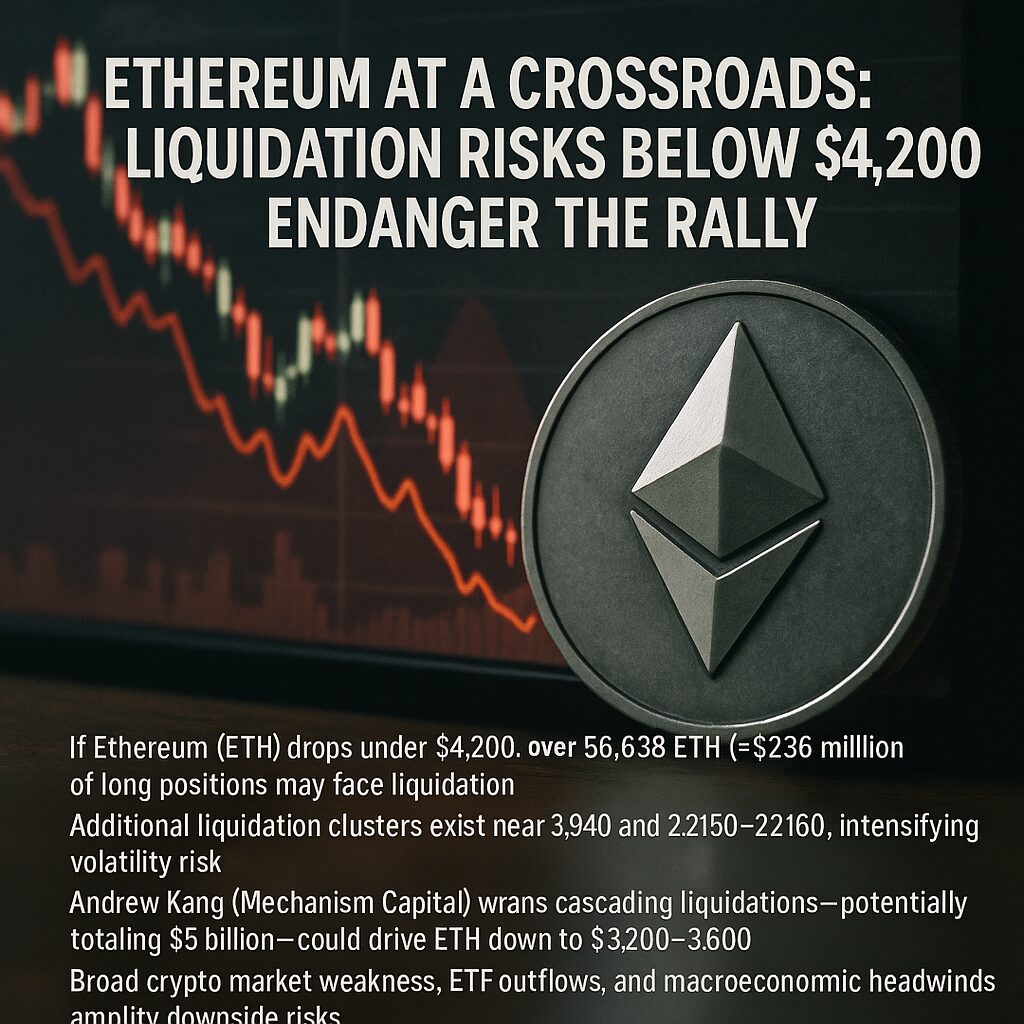
Main Points :
- Ethereum (ETH) trading below $4,200 presents a critical risk zone—over 56,600 ETH (~$236 million) in long positions may face liquidation via Hyperliquid; centralized exchanges could see $520 million in long liquidations or $801 million in short liquidations at $4,450.
- Market watchers, including Andrew Kang (Mechanism Capital), warn total ETH liquidations could exceed $5 billion, potentially pushing prices toward $3,200–$3,600.
- Recent daily liquidations: crypto markets saw over $870 million, with $210 million from ETH alone following a rejection near $4,800.
- If ETH drops below $4,000, cascading liquidations could reach $1–1.19 billion, risking a broader market sell-off.
- Liquidation heatmaps show strong clusters just above $4,800 and just below $4,200—suggesting range-bound behavior unless breakout occurs.
- Institutional positioning: record-high short interest in ETH futures (CME); spot ETFs saw recent outflows amid volatile sentiment; yet standard‑chartered raises year‑end forecast to $7,500, citing regulatory tailwinds.
- Traders should monitor these levels closely— a break below or above could trigger rapid moves; risk management and understanding of leverage dynamics are essential.
Article Body
1. Introduction: The $4,200 Danger Zone
Ethereum’s descent below $4,200 marks a juncture of intense scrutiny—an area where leveraged exposure converges to create potential volatility spikes. Data from the Hyperdash platform shows that over 56,638 ETH, or about $236 million in long positions, are vulnerable if prices slide to $4,170. On centralized exchanges, Coinglass data projects up to $520 million in long liquidations if ETH slips below $4,200, while a breakout above $4,450 could threaten $801 million in short liquidations. This confluence of levered exposure sets the stage for explosive price reactions.
2. The Cascade Effect: When Liquidations Fuel Volatility
Liquidations occur when traders using leverage are forced out—if the price moves against their position and maintenance margin is not met, exchanges automatically close the positions. When a wave of such actions hits en masse, the result is a feedback loop: sell pressure leads to more price declines, triggering more liquidations. Recent events exemplify this—cryptocurrency markets shed over $870 million in liquidations in a single day, with ETH accounting for roughly $210 million, following a rejection near $4,795
3. Downside Risk: The $4,000 Breakdown Scenario
A slip below $4,000 could amplify risks dramatically. Liquidation trackers indicate that a breakdown here could trigger $1 to $1.19 billion in cascading liquidations. Mechanism Capital’s founder Andrew Kang estimates that total ETH liquidations across exchanges could reach $5 billion, potentially dragging prices down toward $3,200–$3,600. Such a scenario would likely roil the broader crypto market, given ETH’s central role in DeFi and altcoin valuation.
4. Heatmap Insight: Liquidity Pools as Price Magnets
Analysis via liquidation heatmaps reveals two key zones acting as magnets: a dense cluster just below $4,200 and one above $4,800. These clusters represent liquidity concentrations where forced trades are likely, often causing price to gravitate toward those levels. Until a clear trend emerges, ETH is likely to oscillate within this band.

5. Institutional Flow and Outlook
Despite short‑term volatility, some long‑term sentiment remains constructive. Spot ETFs had seen strong inflows but recently recorded significant outflows ($272 million withdrawal in one day). Futures markets show elevated institutional short positioning on CME . On the other hand, Standard Chartered raised its year‑end ETH forecast to $7,500 (from $4,000), citing stronger engagement with stablecoins (supported by the Genius Act), staking utility, and expanded Layer‑1 capacity.
6. Trader Strategy: Vigilance, Discipline, and Risk Metrics
Given these dynamics, traders should closely monitor $4,200 as critical support and $4,450–$4,800 as breakout points. Breaks below or above could induce explosive moves due to liquidation cascades. Risk management tools—stop orders, reduced leverage, and awareness of whale movement (e.g., large ETH movements to exchanges often precede sell‑offs)—are essential. Contrarian plays may emerge if support holds, offering buying opportunities for longer‑term positions.
7. Market Implications: Beyond ETH
Ethereum’s moves here may influence the wider crypto landscape. A sharp decline could depress altcoins and DeFi tokens; conversely, stabilization or rebound could restore confidence in on‑chain use cases. Regulatory tailwinds (e.g., regulated stablecoins via the Genius Act) and institutional adoption via ETFs add structural support—while liquidation dynamics dictate near‑term volatility.
8. Conclusion: A Crossroads for Ethereum Traders and Builders
Ethereum is at a pivotal threshold. Breaking below $4,200 risks triggering cascading liquidations that could reverberate across crypto markets. Yet, institutional and regulatory developments suggest long‑term resilience. Traders and developers should remain vigilant, balancing risk with opportunity—understanding that S‑curve adoption depends not only on technological capability, but also on navigating these price inflection points with discipline.

